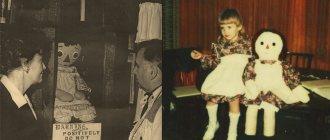Crisis periods occur throughout a person's life. And this is normal, because, according to psychologists, crises are one of the mechanisms of development. Before school, a child goes through several age-related crises: a newborn crisis, crises of 1 year, 3 years. Depending on personal characteristics and a number of external circumstances, these periods can last from several months to two years. At this time, there is a sharp leap in development, which is accompanied by the disintegration of what was formed at the previous age stage. People around the child notice that he becomes capricious, disobedient, and difficult to educate. In this article we will tell you about the causes of age-related crises in children and how they manifest themselves, as well as how to behave with your baby at this time.
Newborn crisis
The reason for this crisis is that the baby from the mother’s womb finds itself in a new environment with completely unfamiliar living conditions. This situation is stressful, the child is forced to adapt to these conditions, mobilizing all his strength. In order to help the baby successfully go through this crisis period, it is necessary to constantly be with him and, if possible, satisfy all his needs on time (feed, bathe, change diapers, hold). Close physical contact is very important.
At this age, the child’s basic trust or distrust in the world is laid. If there is no person next to the baby who constantly takes care of him, this may affect his behavior in the future.
During this period, mother and child have a symbiotic relationship: they feel each other at deep levels. Therefore, for the emotional well-being of the baby, it is necessary for the mother to be calm. All experiences and worries affect the child in one way or another. The main mental development in infancy is direct emotional communication. At about 1.5 months, the baby develops the so-called “revival complex,” that is, an emotional reaction to an adult. Seeing his mother or another loved one, the child smiles, begins to move his arms and legs, and makes sounds. Subsequently, his reactions become more differentiated and dependent on the situation.
Crisis “Mom, don’t go!” (from 9 months, approximately 40 to 47 weeks)
A new physical skill - crawling - changes the baby's ideas about the world around him, now he sees it differently, from a more elevated position. The overabundance of information received in this way changes the child’s way of thinking. All this provokes another growth spurt, which can manifest itself as follows:
- The baby may cry a lot as soon as the mother leaves the room.
- Shyness, especially in front of others.
- Begins to find fault with complementary foods.
- Jealousy appears.
- Needs a lot of attention from mom.
Year 1 crisis
If previously the child perceived himself and his mother as a single whole, then the one-year-old baby begins to defend his right to independence. Having learned to crawl and then walk, the child no longer feels the constant need to be near his mother. On the contrary, a strong research interest in the world awakens in him. For parents who previously carried the baby in their arms and are accustomed to the fact that they can control all of his movements and actions, it can be difficult to adapt to the new state of affairs. As a result, the child is faced with the fact that adults often limit his freedom (“don’t touch this,” “you can’t go there,” and so on). Children of this age react very sharply to prohibitions, becoming capricious and rebellious.
The crisis of the first year of life is a test not only for the child, but also for the parents. Be patient and try to calmly accept the whims of the baby.
At the age of 1 year, the child lays the foundations for such important personal components as self-esteem, self-confidence, and self-esteem. You can help your child develop actively by creating a safe environment for him, in which the child can fully demonstrate his independence. Try to reduce the number of restrictions and prohibitions. Instead, offer your child another interesting activity.
Grof matrices
American psychotherapist Stanislav Grof considered the neonatal crisis in psychology through the stages of childbirth. He identified 4 matrices:
- period of contractions;
- passage through the birth canal;
- the birth process itself;
- first interaction with mother.
According to the psychoanalyst, most mental problems are rooted in the difficulties that the baby encountered during childbirth. To resolve these difficulties, Grof, using special techniques, immersed patients at the moment of birth. He believed that repeatedly going through the four stages, emerging from them without fears, mistrust and other problems is the basis of a healthy psyche.
Crisis 3 years
According to most psychologists, the 3-year-old crisis is one of the most difficult periods of childhood. Sometimes it just takes parents by surprise. After all, very quickly the baby turns from an obedient and “well-mannered” child into a wayward, stubborn and capricious child.
Age crises can have different intensities. Depending on the nature of the baby and the relationships within the family, the manifestations of the crisis may have varying intensity. But the main signs of a crisis are the same for everyone. Famous Russian psychologist L.S. Vygotsky identified the following symptoms of the 3-year crisis:
- Negativism (negative reactions to any requests from adults);
- Stubbornness (even if the baby inside wants to agree with you, it is very difficult for him to do this);
- Obstinacy (rejection of established rules);
- Devaluation (what the child previously liked loses its value);
- Self-will (a three-year-old child wants to do everything himself);
- Rebellion (conflict, defiant behavior);
- Despotism (the desire for power over others).
A three-year-old child can already act contrary to his immediate desires. His behavior is not related to his needs, but to his relationships with adults.
The reason for the 3-year-old crisis is the formation of the child’s “I”. Around this age, the baby begins to separate himself from the outside world. A three-year-old child strives for independence and moves away from adults, establishing new, deeper interpersonal relationships with them.
For a child who is at a critical stage of development, adult support is very important. Despite his desire to be independent, he is still a child who is just getting to know himself and the world around him, testing the boundaries of what is permitted. Don't scold your child for not listening and throwing tantrums. A three-year-old child does not behave this way on purpose, he simply cannot do otherwise.
A small child cannot cope with strong emotions on his own. Only the presence of a loved one nearby, support and acceptance on his part allows the baby to feel safe and release his emotions.
This, however, does not mean that there should be no prohibitions in a child’s life. They are necessary (for example, you cannot climb on a windowsill or stick your fingers into a socket), but there should not be too many of them. For this to be feasible, it is necessary to create the safest possible environment for the child at home by removing dangerous objects from his or her reach. In situations where this is possible, give your child freedom and allow him to be independent. If you see that something is not working out for your child, do not rush to do everything for him. “Help me do it myself,” is the motto of Montessori pedagogy. But sometimes there are situations when the baby demands the impossible: for example, he wants to chop wood like dad. Then you can offer him a couple of other alternative activities to choose from (help dad carry the logs or put them in the cart). This way, the child will most likely feel that he made the decision himself and hysteria will be avoided.
Crisis of the eighth month (from the 32nd to the 38th week)
The baby begins to understand speech, becomes more emotional, hears and sees objects better, observes more what is happening around him, and wants to try new foods. What can you notice in his behavior?
- Cry.
- Apathy.
- Some children want to be more affectionate: they hug and ask to be kissed more often, they want to be closer to their mother.
- They start to feel shy.
- The child seems to go back in his behavior and become “like a little one.”
- Protest while changing clothes.
- Taste preferences change.
How to cope: advice from psychologists
The age crisis is a difficult period for a child. In order for it to pass with the least loss to the nervous system, it is necessary to build a single line of behavior
This is especially important if grandparents live with the baby and his parents. A single line of behavior will help the child learn norms and accept prohibitions
Basic advice from experts in developmental psychology:
- Minimum restrictions and safe space. Restrictions should only be related to hazardous factors. You cannot touch sockets, run out onto the roadway, approach dogs on the street, or lean out of the window. Minimize the word “no”, put potentially dangerous, valuable items in an area inaccessible to the baby. If this is not possible, install special protection on cabinet doors. It will also be needed for sockets and windows.
- Leave your baby's favorite toys within reach. Pots, unbreakable cups, plates, broken household appliances will keep your baby occupied for a long time.
- Children after one year love to imitate their elders. This is a great way to keep your son or daughter busy. Let them help with cleaning and cooking. Give the baby a cloth and let him wipe accessible surfaces. Two pots and a cup will bring a lot of joy to the little discoverer.
- Don't force feed. Invite your baby to eat with adults. This way he will feel equal to adults. If possible, offer food from your plate. But it should be without hot sauces and undergo gentle heat treatment.
Communicate more, play with your baby. Spending time together, kindness, and care are the key to the future success of a son or daughter. The child must understand that he is loved, appreciated, accepted.
Mom and dad should try to understand the baby’s language and gestures. This will make communication easier and minimize hysterics. They can be used by a child as manipulation. He tests what he can achieve in this way. As a rule, at such moments it is easy to switch the child to another activity that interests him.
If you can’t switch the baby, let him cry. Just hug and wait until the baby calms down.
It is important for adults to control themselves. Before you lash out at your child, try to calm down.
Relax, breathe deeply, try mentally counting to 10 and exhale deeply. A breakdown will only worsen the situation and scare the baby.
Mother-child dyad
In developmental psychology, the concept of dyad is distinguished - “mother-child”. It considers a woman and a baby as a psychologically single organism.
Therefore, in the first months, regular psychological and physical contact between mother and child is so important.
Closer to one year, the child will make his first attempts to separate from his mother and will begin to show independence. At this moment, it is important for the woman to “let go” of the baby and begin to separate herself from him psychologically.
Features of a newborn
Most of the time, babies sleep or are half asleep. They are sensitive to changes around, the departure of the mother or sharp sounds.
Behavior is based on unconditioned reflexes, thanks to which the baby can survive in new conditions. Thanks to them, he can breathe, his gastrointestinal tract digests mother's milk, and the excretory system functions. Closer to three months, conditioned reflexes and a behavioral system begin to form.
The first thing a newborn recognizes and identifies is a human face. He begins to distinguish his mother from other family members. The child also reacts to the voice, he is able to pick up intonations.
The newborn period is considered the first three months of a child’s life. Afterwards, the term baby is already used for him. It is characterized by the so-called transitional development.
Its signs are considered:
- Nutrition. On the one hand, the baby feeds on mother's milk, on the other hand, he must obtain it himself.
- Fetal position. Most often, newborns sleep in this position.
- Movements. Most reflexes in the first months of life are considered atavistic and fade away. Instead, conditioned reflexes are formed.
- Lack of clear distinction between sleep and wakefulness. Often sleep is superficial.









